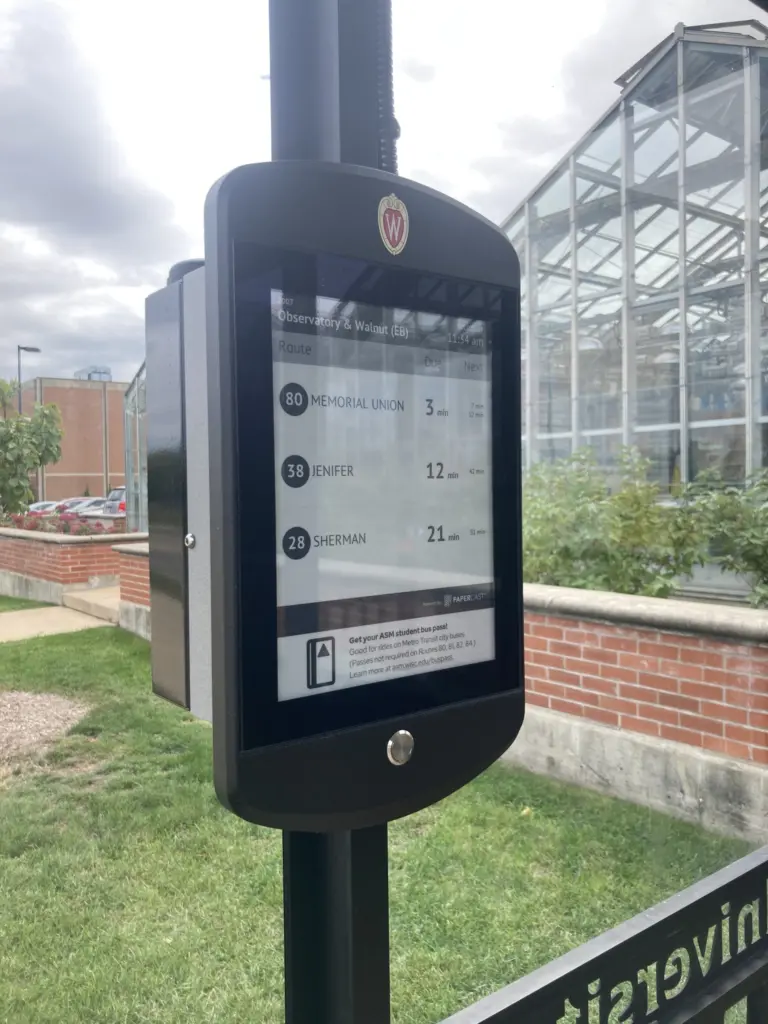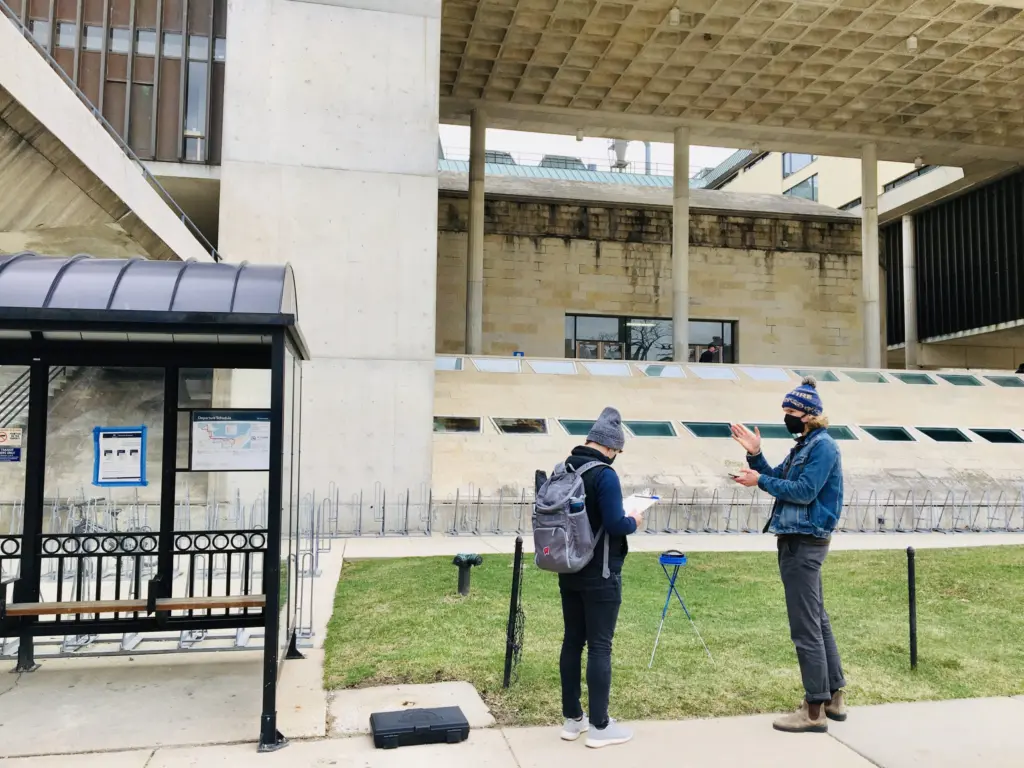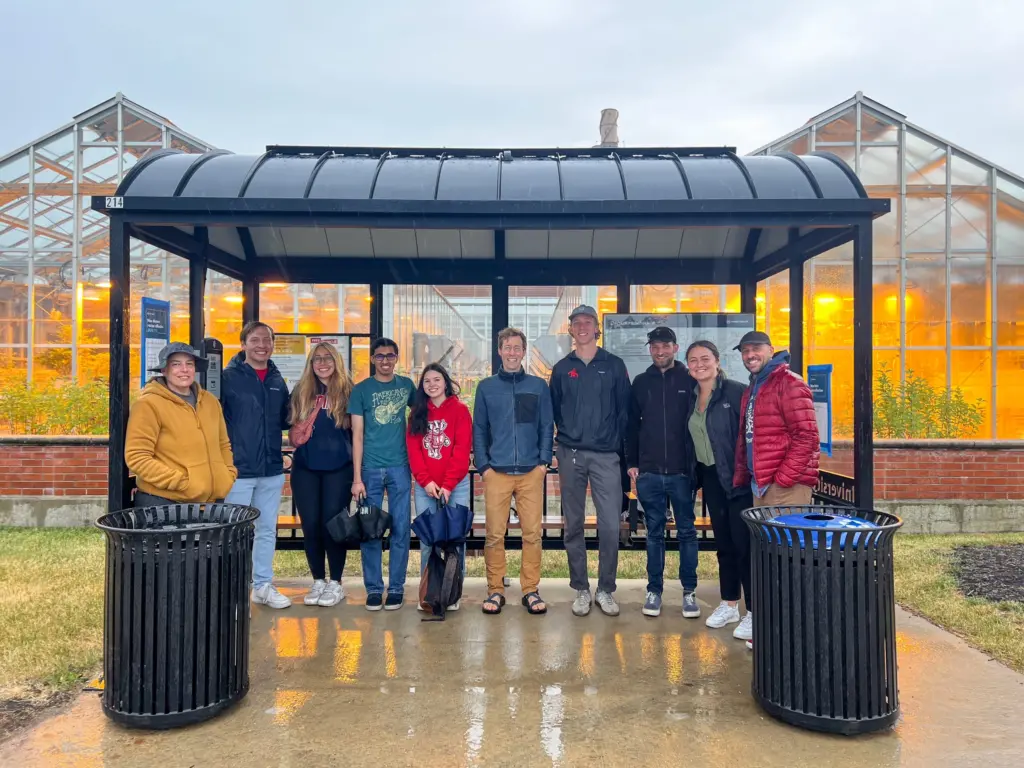As bus riders traverse the University of Wisconsin–Madison campus, they may notice a few enhancements to the transit landscape: screens delivering real-time arrival information and overhead lights that illuminate late-night and early-morning commutes. What they may not immediately recognize are the inconspicuous solar panels integrated onto the curved roofs of 20 campus-managed bus shelters, silently powering these improvements.
These features represent more than just technology advancements; they symbolize a collaborative effort to enhance the safety, convenience, and sustainability of campus transportation. With an additional 17 shelters set to receive these upgrades in Spring 2024, followed by 10 more in 2025, the project’s positive impacts continue to expand, marking a significant stride toward a greener and more efficient campus transit system.
The journey started in the Fall of 2019 when three students from Enactus reached out to the Office of Sustainability to pitch a Green Fund project. Initially, their vision was to add solar panels to a campus parking structure. Following discussions with Transportation Services, they happily shifted their focus to electrifying bus shelters.

The new focus presented a unique challenge and design stipulation: how to integrate solar panels—which are typically flat and rigid—onto the curved roofs of the bus shelters in a way that preserved their aesthetic. Rather than using flat panels, the team wanted to use flexible, curved panels that would lay flush between the ridges of the roof. In addition, the team needed to know how many solar panels would be required to generate enough electricity to power the screens and lights. The orientation of each shelter and the shading from the surrounding buildings and trees would affect the production of these panels.
To tackle this issue two student organizations united: Enactus, with its background in project management and sustainability, joined forces with Helios, which is proficient in renewable energy engineering and computer science.
The students took to the streets to analyze the solar potential of all 66 bus shelters on campus, using a tool called a Solar Pathfinder to assess the orientation and shading of each location.
Computer programs exist for estimating the electrical output of flat solar panels. Nothing exists, though, for curved panels. With the support of Arganthael Berson, an assistant teaching professor in the Department of Mechanical Engineering, the students approximated the curvature by modeling a series of flat solar panels, each at a different angle of tilt. By running the shading and orientation data through the curved panel model, the team, which included mechanical engineering students Simon Brooks (BSME ’23) and Tyler Graczyk (BSME ’22), was able to recommend which of the 66 bus shelters would be appropriate sites for solar panels and how many panels would be needed at each.
After 3 ½ years of planning and collaboration, UW–Madison installed the first solar bus shelter upgrades in the summer of 2023. Partners from Transportation Services, the Office of Sustainability, Helios, Enactus, and the installer, Urban Solar, came together to celebrate this monumental achievement.
“Inviting all the students who worked on the project over the years, including those who graduated, to observe and celebrate the installation, you could feel the sense of accomplishment and enthusiasm as we gathered under the shelter on a rainy day to geek out with the installer about the technical details of the system,” says Ian Aley, program manager for the Green Fund.
The Urban Solar representatives shared that while they have designed and installed solar bus shelters across North America, this was their first time working with curved panels. They learned a great deal through the process and will start offering curved panels as an option for future customers, expanding the project’s impact beyond the UW–Madison campus.
Read more about how the real-time bus arrival displays and lighting will improve the travel experience on campus.
A version of this story was originally published by the UW-Madison Office of Sustainability.
 Students Tanner Wagner-Durr and Simon Brooks, of Enactus and Helios respectively, took to the streets to conduct a feasibility study. Using a Solar Pathfinder, they assessed shading across all 66 bus shelters maintained by UW–Madison to gauge solar panel viability.
Students Tanner Wagner-Durr and Simon Brooks, of Enactus and Helios respectively, took to the streets to conduct a feasibility study. Using a Solar Pathfinder, they assessed shading across all 66 bus shelters maintained by UW–Madison to gauge solar panel viability.
 A contractor places flexible solar panels atop a bus shelter on Engineering Drive. The unique, flexible design of the panels was a student-driven solution developed with support from Arganthael Berson, an assistant teaching professor in mechanical Engineering. Once in place, the panels bend over the shelter’s curved roof, with the projected potential to generate more power than flat panels while maintaining shelter aesthetics.
A contractor places flexible solar panels atop a bus shelter on Engineering Drive. The unique, flexible design of the panels was a student-driven solution developed with support from Arganthael Berson, an assistant teaching professor in mechanical Engineering. Once in place, the panels bend over the shelter’s curved roof, with the projected potential to generate more power than flat panels while maintaining shelter aesthetics.
 A solar installer mounts a display screen inside a bus shelter on Engineering Drive, marking the completion of the 20th and final solar bus shelter installation of the summer.
A solar installer mounts a display screen inside a bus shelter on Engineering Drive, marking the completion of the 20th and final solar bus shelter installation of the summer.
 Project partners gather in celebration beneath a newly completed solar bus shelter by the Walnut Street Greenhouse.
Project partners gather in celebration beneath a newly completed solar bus shelter by the Walnut Street Greenhouse.